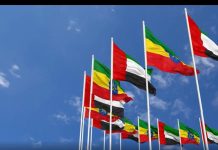Africa-Press – Ethiopia. Addis Ababa May 20/2021 (ENA) The international community has made major progress towards the global target on protected and conserved area coverage, but has fallen far short on its commitments on the quality of these areas, according to the Protected Planet Report.
UN Environment Programme World Conservation Monitoring Centre (UNEP-WCMC) and the International Union for Conservation of Nature (IUCN) released the Protected Planet Report on Wednesday that indicated the overall situation of protection and conservation of natural resources across the globe.
According to the report produced with the support from the National Geographic Society, great progress has been made since 2010 with over 22 million km2 of land and 28 million km2 of ocean protected or conserved and 42 percent of the current coverage added in the last decade.
However, a third of key biodiversity areas lack any coverage, and less than 8 percent of land is both protected and connected, the report added.
The latest edition of the biennial Protected Planet Report is the final report card on Aichi Target 11 – the global 10-year target on protected and conserved areas which aimed to bring important benefits to both biodiversity and people by 2020.
“Aichi Target 11 included the aim of protecting at least 17 percent of land and inland waters and 10 percent of the marine environment. Today, 22.5 million Km2 (16.64 percent) of land and inland water ecosystems and 28.1 million km2 (7.74 percent) ofcoastal waters and the ocean are within documented protected and conserved areas, an increase of over 21 million km2 (42 percent of the current coverage) since 2010,” the new report reveals.
The Protected Planet Report concludes that the challenge will be to improve the quality of both existing and new areas to achieve positive change for people and nature, as biodiversity continues to decline, even within many protected areas. The IUCN Green List Standard is the only global measure of an overall change in quality.
The report calls for existing protected and conserved areas to be identified and recognized, by accounting for the efforts of indigenous peoples, local communities and private entities, whilst recognizing their rights and responsibilities.
UNEP-WCMC Director, Neville Ash said “protected and conserved areas play a crucial role in tackling biodiversity loss, and great progress has been made in recent years on strengthening the global network of protected and conserved areas.”
The director added “however, designating and accounting for more protected and conserved areas is insufficient; they need to be effectively managed and equitably governed if they are to realize their many benefits at local and global scales and secure a better future for people and planet.”
IUCN Director General, Dr Bruno Oberle said “IUCN welcomes the enormous progress made, particularly over the last decade, with protected areas covering a growing proportion of the globe.”
“As biodiversity continues to decline, we now call for Parties at the UN Biodiversity Conference in Kunming to set an ambitious target that will ensure protected area coverage of 30 percent of land, freshwater and ocean by 2030 – and these areas must be placed optimally to protect the diversity of life on Earth and be effectively managed and equitably governed,” the director general pointed out.






